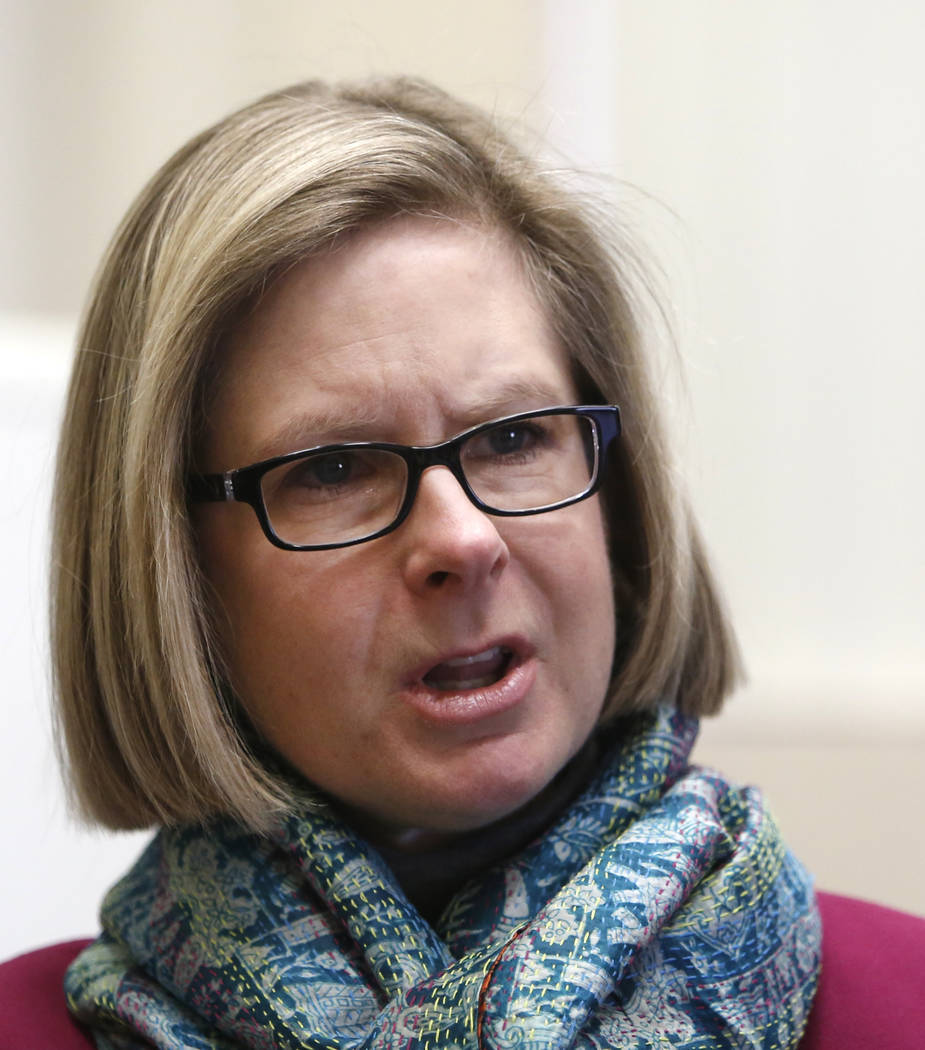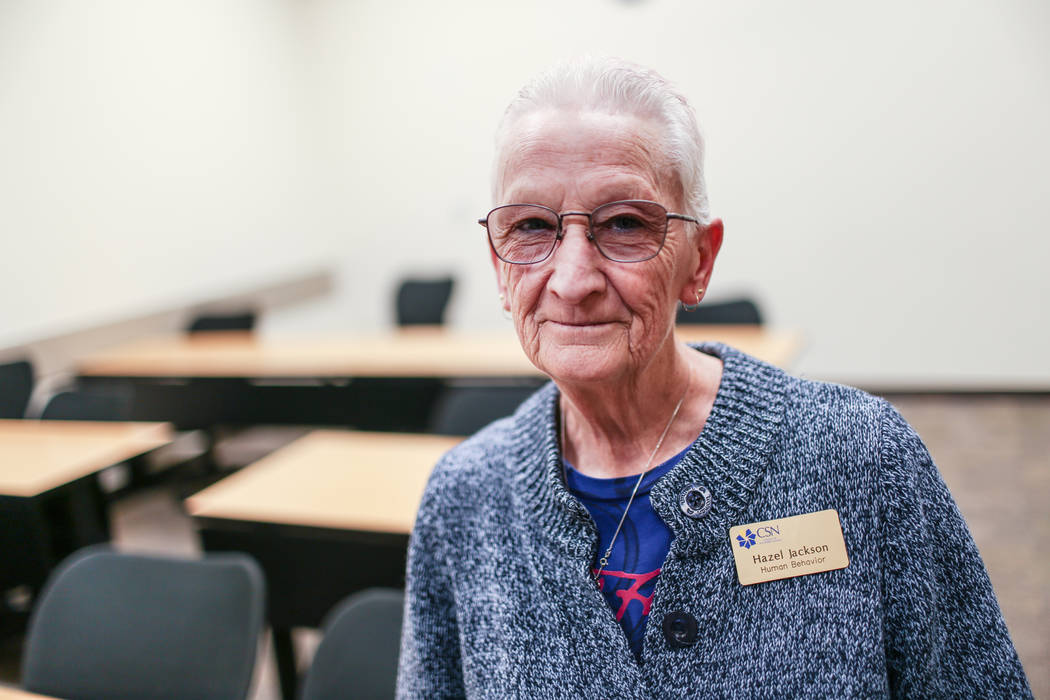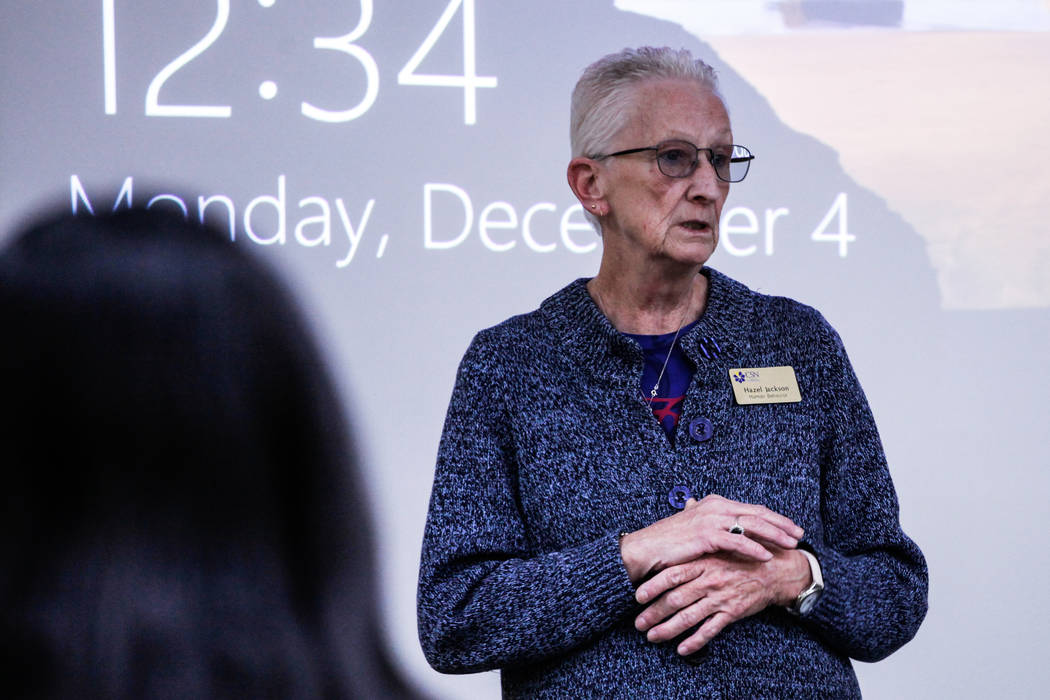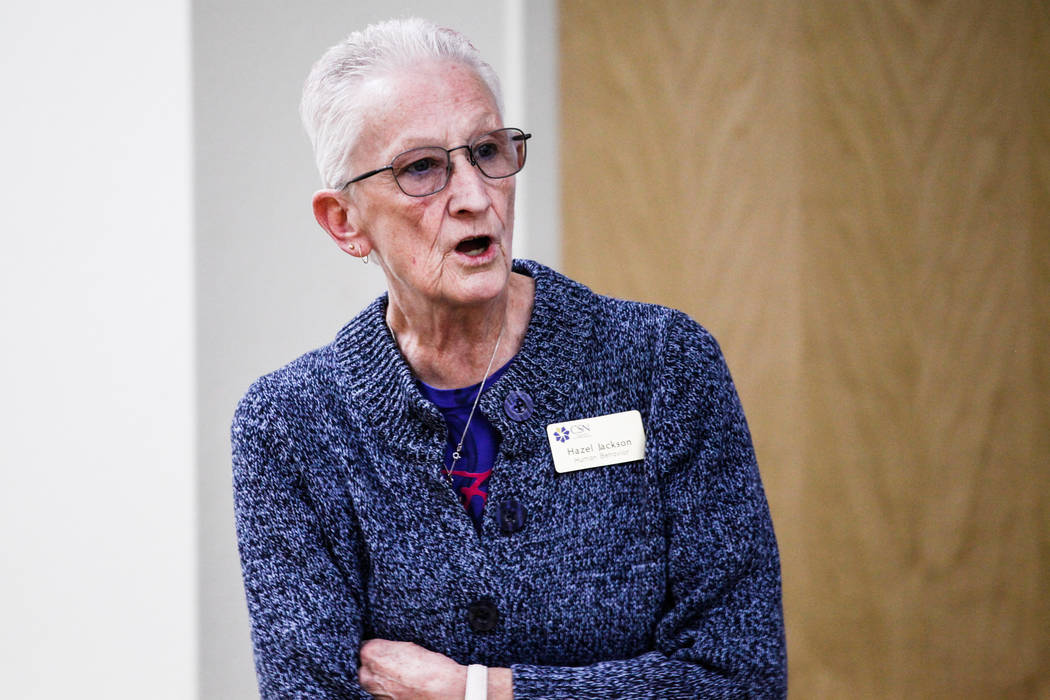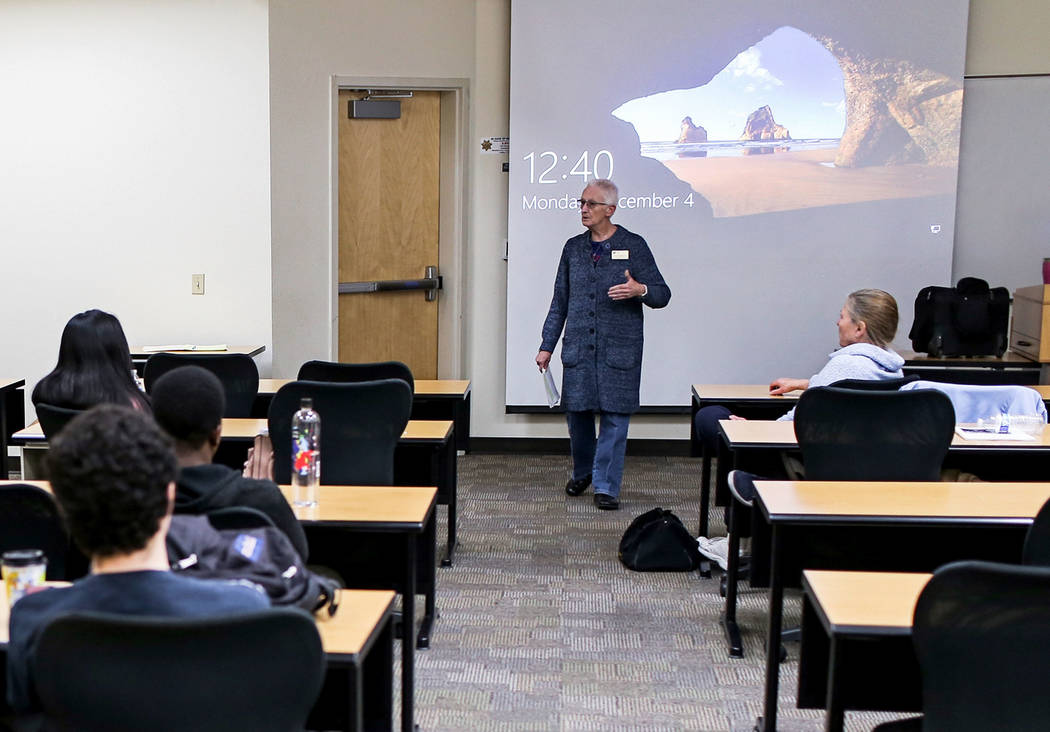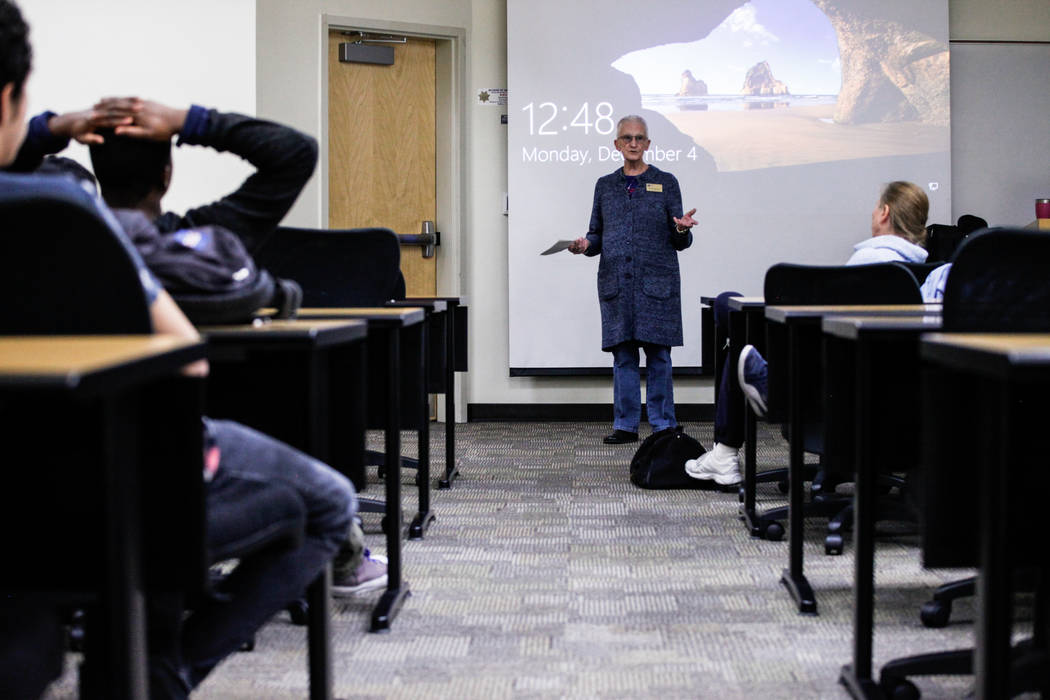Nevada’s part-time professors are bulk of college staff, but pay is low
When the chemotherapy took her hair and her energy, Hazel Jackson was at the front of a classroom, teaching her students.
“That was a little tough with teaching, but kids were very supportive,” Jackson said. “They knew. I came in with my bald head.”
Now, her short, spiky hair is stark white, with a tinge of light pink at the top — a daily reminder of her victory over stage 4 breast cancer.
Jackson, a self-described hippie and out-of-the-box thinker, has been a steady hand for her students through not only her 2011 battle with cancer — when she missed only two classes — but also the daily challenge she faces of making ends meet as a part-time college professor.
“The money would be nicer if we could get more,” Jackson, 68, said. “I’ve been doing this for so long, I think you get to a point where you just accept it, because you love what you do.”
She and the more than 700 adjunct instructors at the College of Southern Nevada are paid $825 per instructional unit. Adjunct faculty comprise 57 percent of the college’s teaching staff.
Most adjuncts, including Jackson, aim for a workload of three courses each in the fall and spring, and two in the summer.
Jackson believes they should get more, especially because UNLV part-time faculty — who make up 40 percent of the university’s teaching staff — got a raise this semester. An adjunct instructor at UNLV can earn $1,200 per instructional unit.
“That puts us at a one-down, and I don’t think any of us like being put at a one-down,” said Jackson, who teaches cultural anthropology. “Whatever they’re getting at UNLV, we should be getting here.”
Many issues
Margo Martin, the new vice president for academic affairs at CSN, said the increase has affected the ability of Nevada’s largest community to retain part-timers.
“When another institution can pay $1,000 more per course, that’s a pretty significant chunk of change,” Martin said. “When you talk about face-to-face classes, or blended, hybrid classes, we’re depending on people who are in here in the valley, and who are within a range to commute,” Martin said. “We’re all competing for a lot of the same talent.”
CSN canceled six classes this fall because nine adjuncts left for the higher pay at UNLV, Martin said.
“We ran out of math faculty,” she said.
Full-time faculty also were overextended, with 14 teaching seven classes rather than the usual five.
“We were able to scramble a little bit and find full-time faculty who were able to do an overload or a double overload, which we don’t like to do because we want to make sure our faculty have work-life balance,” Martin said. “So we were able to cover most of the classes.”
The shortage also meant that some part-time faculty, who were previously capped at 10 instructional units, or about three classes per semester, were given additional courses. This qualified 28 part-timers as teaching a full-time load, meaning the college had to offer them health benefits.
“It really comes down to the (Affordable Healthcare) act,” Martin said. “If you’ve got someone who is working part-time, you want to make sure they’re held to those part-time hours, otherwise you’re in the position of having to pay benefits.”
Nonetheless, the college must be mindful of that, especially as CSN looks to accept the first students from the state’s new Promise Scholarship program. More than 9,000 high school seniors in Southern Nevada have applied for the last-dollar scholarship, meaning the college could see the need for gateway courses — math, English, history and psychology — quadruple in fall 2018.
However, increasing the rate CSN pays per instructional unit by just $25, from $825 to $850, would add $350,000 to the annual budget, Martin said. CSN’s budget for 2017-18 is $143 million.
Meeting UNLV’s rate of pay would add $5.25 million to the 2019-2020 budget, Mary Kay Bailey, CSN vice president of finance, told the institutional advisory council last month.
“We’ll see how the budget plays out and how CSN prioritizes that need,” Chancellor Thom Reilly said. “There’s a limit to dollars, and there has to be some decisions made on where to prioritize that.”
Reilly said adjunct pay hasn’t moved much over the years since he earned about $2,000 for a three-credit course 15 years ago.
“Historically, the salary for part-time faculty has been low,” he said. “It’s one of the many issues that needs to be addressed.”
Moreover, CSN has been unable to meet the salary target set by the Board of Regents in 2013, which advises community colleges to pay adjuncts $1,017 per credit hour. UNLV’s target is $1,130 per credit hour.
“Ideally we should be at a $1,000 per credit hour,” Martin said. “We are not even close to reaching that goal, and with the way funding is currently structured, to get to that target we’d have to make some pretty significant cuts in other areas.”
A fighter
Martin said a differentiation in pay between the community college and university level is reasonable, but the more than $1,000 variation is a glaring disparity.
“It creates a challenge for the community college to be able to attract individuals who perhaps are relying on that rate of pay to be able to pay their bills and meet their financial needs,” Martin said. “Adjunct faculty should be a paid at a rate that demonstrates their value to the institution, and their value to students.”
When Noemi Flores entered college, she sought classes taught by part-time instructors.
“They seemed to be more understanding of students,” said Flores, now 29, who is graduating from UNLV in May. “It seems like part-time staffers are more willing to help the student and make sure they have success.”
This semester, Jackson taught two introduction to anthropology courses at the North Las Vegas campus and a night class in Henderson. She doesn’t have an office, but meets with students anywhere she can, including a local coffee shop or study rooms at the campus library.
She prepares the syllabus for her classes and shares her cellphone number with her students.
“You have to be there for your students,” Jackson said. “It’s the most important thing, because you want to see them succeed.”
When she’s able to secure the maximum of three courses, she takes home about $1,160 a month.
“You hope you get three because that’s how you live, basically,” Jackson said.
It’s more difficult in the summer when there are fewer classes and the maximum course load is two.
She and her daughter — also a part-time instructor — share an apartment, and the two pool their resources to pay their monthly bills. They also care for Jackson’s four grandchildren, two in high school, one in middle school, and the youngest in elementary school.
Jackson supplements her income with Social Security, but it’s still tough to make the pieces work together, she said, especially with a car payment and the cable and internet bill.
Prior to moving to Southern Nevada, Jackson taught at California State University, Bakersfield. But since arriving in Henderson, she’s focused her energy on shaping the minds of community college students, and doesn’t want to teach at UNLV.
“I don’t like a university setting,” she said.
But despite the low pay and frustration, she keeps coming back for her students.
“I’m a fighter,” Jackson said. “I just keep going. I love what I do. I love the students. The people are good here.”
Contact Natalie Bruzda at nbruzda@reviewjournal.com or 702-477-3897. Follow @NatalieBruzda on Twitter.
'An insecure feeling'
'An insecure feeling'
Dr. Daniel Asera, who taught part-time for 13 years at UNLV, said the university should consider granting one-year contracts to adjunct professors.
"We don't know from semester to semester how many, if any, classes we're going to teach the following semester," Asera, 70, said. "That's an insecure feeling."
Asera, who teaches courses in the university's Mathematics Learning Center to supplement his income from his consulting business, said he would be able to better plan ahead if he was guaranteed work for 12 months.
"The not knowing makes a big difference," he said.
A few years ago, his colleague left UNLV to work as a manager at a big-box retailer.
"If I were young and had kids and a big family to support, I would be very insecure," Asera said.










